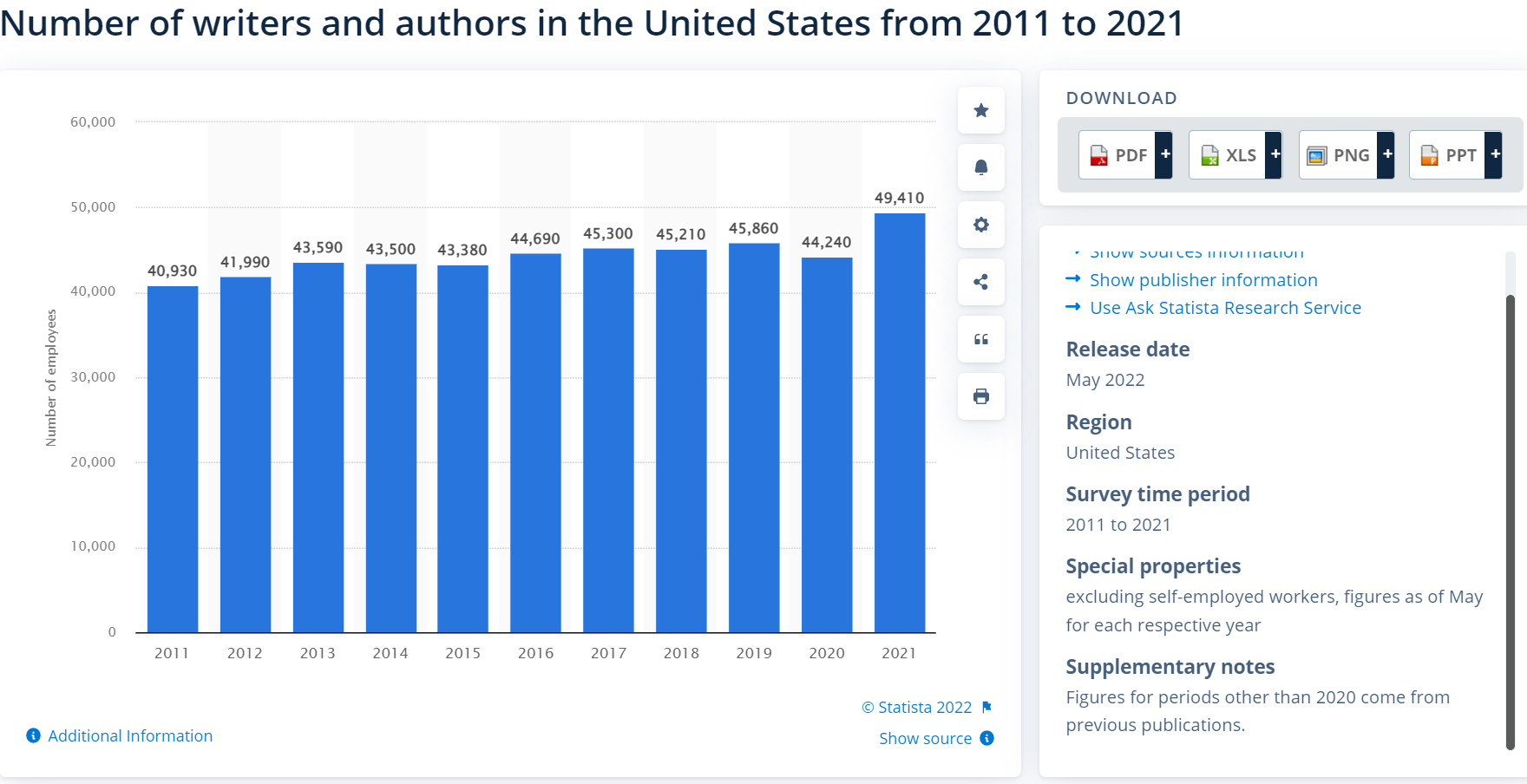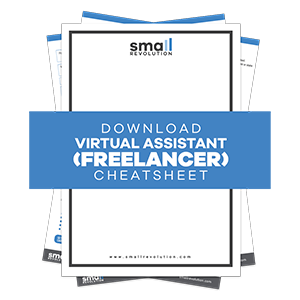Do you fit into one of these categories?
- You love writing, are fairly good at it, and you want to turn it into a career
- You know you want to become a professional writer, but you’re uncertain as to what type of writing to pursue
- You’re a newly retired professional who would like to give writing a try as a second, work-from-home career or as a “spare cash” opportunity
- You freelance in another field like web dev or design and want to add writing to your services
- You want that “laptop” lifestyle you see in the ads and memes
If so, then you’re in the right place.
Today, we’ll be examining 10 statistics on the freelance writing lifestyle and earning potential. By the time you finish reading, you’ll be ready to decide if freelance content writing is right for you.
And if you decide that freelance writing is what you want to do, we’ll look at a few inexpensive courses you can invest in to get that new career or side hustle as a paid, professional freelance content writer off the ground.
Just a note: We’re taking off the rose-colored glasses here. Yes, there are plenty of good things to present to you, but we’ll also discuss some of the not-so-good, to give you a fair and balanced look at your potential future.
Earning Potential Stats for Freelance Content Writers

Positive Job Growth and Increasing Income Potential
Let’s begin by looking backward before we look forward; backward as in the last 10 or so years.
The chart below from Statista shows that the number of writers and authors in the US has grown steadily over the last decade.

With the exception of 2020, when the pandemic caused the lay-offs of thousands of journalists by news and media outlets, the field has shown progressive growth. The US Bureau of Labor Statistics expects the growth to continue, increasing by 9% by 2030.
So, the potential for a future content writing freelance career is certainly there:
Stat #1: Freelance writing jobs have grown steadily over the last 10 years.
Stat #2: That growth is expected to continue until at least 2030.
Now, let’s look at how lucrative that career can be.
Freelance Content Writer Salaries
Most freelance content writers are paid by the word; from 1 cent a word to $1. According to a recent survey, the average per word salary is 5 to 15 cents.
ZipRecruiter reports that the average hourly wage for freelance content writers in the US is $30. And the average yearly income from freelance content writing is a little over $63,000.
The wide range of earning potential is the result of several factors, the most important being the niche or industry that the writer has chosen. Some are more profitable than others. Some of the highest paying industries currently are:
- Finance
- Technology
- SaaS
- Alternative Health
- Cannabis and CBD
- Mental Health
In a bit, we’ll also look at how the type of content a writer chooses to write can affect their earning potential, too. First, let’s summarize these additional stats:
Stat #3: The average freelance writing salary per word is 5 to 15 cents.
Stat #4: The average hourly wage is $30.
Stat #5: The average yearly income is $63,000.
Possible Low Wages and Income Inequality
Remember that 1¢/word pay we mentioned above? That’s thanks to “content mills,” the freelance writing world’s equivalent of sweatshops.
Many mills masquerade as legitimate agencies or publishers. So, how do you avoid the trap of working for a content mill? Here are the warning signs that an “agency” may be a mill, or close to it:
- The pay is low, often only 1 to 4 cents per word.
- The content is all about the SEO score and not about the humans reading it.
- No one knows who the writers are. No bylines are given, no writer bios or profiles anywhere like LinkedIn or a “team” page on the website.
- The focus is on quantity over quality. The more content created, the more the “agency” or marketplace gets paid, and that’s all that matters.
Content mills have their place in the freelance writing world, though, so they’re not all bad.
They’re a great place for beginners to learn the ropes of the business. They offer flexible schedules, a way to earn some cash fast and get acquainted with things like deadlines, keywords, and time management.
And then there’s the income inequality. It might be that the higher-paying industries are tech-y and science-y stuff, and more prone to attract men. It might be just the good ol’ gender gap at play, but Skillscouter’s stats show that male freelance writers make up to 4X more than their female counterparts:
Stat #6: Male freelance writers often make more than their female counterparts.

The Most Profitable Types of Content to Create
There’s a rule in content marketing that basically says the more work your content does for the business, the more it’s worth. That’s why the type of content a freelance content writer creates can determine how much they can earn from it.
The top three most profitable types of content, in order, are listed in the table below, with the range of fees a writer can charge for them.
| Type of Content | Average Fees |
| Long-form blog content (2000+ words) | $250 to $500 per post |
| eBooks (10 to 20 pages) | $1,500 to $5,000 |
| White papers (5 to 10 pages) | $5,000 to $7,000 |
Now, you may be looking at this and wondering, if they only cost $250 to $500 each, how could blog posts be the most profitable type of content a freelance writer cancreate?
The answer is simple: quantity. A business may only need one or two eBooks a year; the same goes for white papers. Blog posts, however, are published at least weekly, sometimes more than once a week.
That type of need is why many blog writers can set up retainer arrangements worth thousands every month. They sell “packages” of 4, 8, and even 12 blog posts for $250 to $300 each.
When a writer can make those kinds of arrangements with even just a handful of clients, they can have a steady, safe, secure income stream—no starving artist types among good freelance blog writers.
As for the $1 per word writers? Most of them work for trade magazines or industry media outlets.
They write long-form articles published in both print and digital formats. And they are usually highly specialized in their field, often coming from within that field before becoming a writer.
This knowledge brings us our final stats:
Stat #7: Blogging is the most profitable type of freelance writing.
Stat #8: eBook writing is the second-most lucrative type of freelance content writing.
Stat #9: White papers are the highest-paid single project type of freelance writing work.
Stat #10: Highly specialized freelance content writers working for trade magazines can earn up to $1 per word.
How Do You Become a Writer?
No one is born a writer. There may be an innate talent for language and wordplay, but all writers are taught in some way or another.
They may be self-taught and we all learn some language skills in school. Many freelance writers, however, combine their talent and love for writing with instruction from qualified professionals. And you can, too.
We’ll look at three courses, two offered by the online education platform Udemy and our very own “become a blog writer” course here at Small Revolution. You might benefit from taking all three, as they each cover different aspects of the freelance content writing world.
Start a Profitable Freelance Writing Business in 5 Weeks – Udemy
This course assumes you can already write, and write well enough to get paid for it. Its focus is more on becoming a professional writer who offers their skills to clients for pay.
It teaches you aspects of the professional writing life, such as:
- Setting up your website
- Creating a portfolio
- How to market your writing business
- How to hire help when the work becomes overwhelming
It’s not really a course for beginners who have never written before, as it doesn’t teach you how to write. But for those who are confident in their writing skills and are ready to jump into the freelance content writing world, it’s jam-packed with valuable, actionable information.
Here’s what student Paul Micelli had to say about his experience:
What Arfa (the instructor) delivered was a clear and workable blueprint of a writing business that’s geared towards profit..
The Complete Freelance Writing Course – Udemy
Udemy’s Complete Freelance Writing Course does teach you how to write, and many, many types of commercial writing, including:
- Podcasts
- Blog posts
- Web copy
- eBooks
- White papers
- B2B copywriting
- Video
- Speeches and presentations
- Apps
By the end of the course, you’ll have created a portfolio to impress any potential client. The course briefly touches on marketing and other aspects of freelance writing professionally that are covered in more depth in the course above.
That’s why we suggest taking both, and not just one if you are new to freelance writing.
The Small Revolution Blog MasterCrafter Course
In the old days, you received your vocational training by first becoming an apprentice or novice. You then moved up to journeyman, and finally, at the top of your skill and earning potential, you were given the title of MasterCrafter.
Small Revolution wants to help you jump the bit in the middle and go straight from beginner to MasterCrafter. We’ve developed our own blog writing course from the training we use with our own in-house writing team. And while it’s not ready yet, it will be soon.
It focuses solely on how to create those highly sought-after blog posts that every business is clamoring for. If you’ve never written a blog post in your life, you’ll still be able to go from raw beginner to blogging MasterCrafter in a few short weeks.
What’s Your Next Step?
Have you decided that the freelance content writer life is the one you want? We hope so.
If not, you may be interested in one of our other courses. Or check out our blog for valuable, informative articles on other in-demand online careers available to you.
Small Revolution’s mission is to help you have the online career of your dreams. If that’s becoming a freelance writer, you’ll be well on your laptop-lifestyle way.
Share on Facebook:



